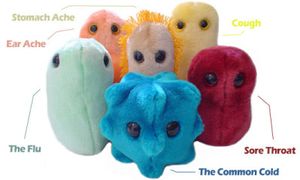New Directions: Linking Mental Illness with Microbiota
The gastrointestinal (GI) tract in humans provides a home for many (1014) bacterial organisms. The colonization of the GI by bacteria, or microbiota,  starts at birth and continues throughout early development and life. These microbiota affect many bodily functions, aiding metabolism, modulating inflammation, and defending against harmful micro-organisms. Each person has a unique profile of microbiota, which is influenced by genetics and the environment. Healthy people, however, generally have similar numbers and distributions of microbiota. Interestingly, disorders of the GI tract have a high comorbidity with mental illness.
starts at birth and continues throughout early development and life. These microbiota affect many bodily functions, aiding metabolism, modulating inflammation, and defending against harmful micro-organisms. Each person has a unique profile of microbiota, which is influenced by genetics and the environment. Healthy people, however, generally have similar numbers and distributions of microbiota. Interestingly, disorders of the GI tract have a high comorbidity with mental illness.
It is not surprising then that research in this field has grown, with labs hoping to gain a better understanding of the ‘gut-brain-axis.’ If these labs can elucidate the effect of microbes in the GI tract on the central nervous system, they could shed light on why more than half of patients with irritable bowel syndrome meet the criteria for mood disorders, or how GI tract disorders and mental illnesses can be more effectively treated.
Many researchers are currently focusing on how variations in the composition of microbiota impact physiology and contribute to disease, such as obesity and inflammation. Increasingly, studies have been revealing that these microbiota communicate with the brain and influence its function and behavior, potentially by neural, endocrine, and immune pathways.
In 2010, Jane Foster and colleagues at McMaster University in Ontario found that microbiota may affect gene activity during central nervous system development. They compared how germ-free and normal mice act on an

Elevated plus maze used for testing anxiety-like behaviors in mice (from the Mouse Phemone Database)
elevated plus maze (shown to the right) that is used for testing anxious behaviors. Normally, mice avoid areas they might be seen and spend more time in the less visible arms of the maze.
While the normal, control mice did spend more time in the ‘closed’ over ‘open’ arms, germ-free mice spent more time in the open arms, exploring them and showing less anxious behaviors. After the experiment, Foster and her team examined the brains of the mice and found alterations in the gene expression levels of several genes in the germ-free mice, particularly in those affecting brain-derived neurotrophic factor (BDNF) and serotonin (5HT). BDNF and 5HT had been previously suggested to affect emotion and anxiety.
Importantly, the study shows that the absence of microbiota can alter behavior and suggests that the microbiota in the GI may impact gene expression during the sensitive period of early brain development. Although studies in mice need to be proven translatable to humans, a pediatrician was interested in collaborating with Foster to determine if he could determine a way to fix the microbiota profile of some of his patients before puberty.
Using germ-free animals and animals exposed to infections, researchers have suggested a role for microbiata in regulating mood, anxiety, cognition, and pain. More research is needed to decide whether formulating or modifying gut microbiota could serve as a possible therapeutic for central nervous system disorders. Foster suggests combining preclinical work on microbiota with clinical work on the impact of antibiotics and probiotics on brain development and function. This could allow researchers to better understand bottom-up control and provide inspiration for novel interventions in mental illness. In the end, communication between scientists and clinicians in various fields and domains is crucial to determine the relationship between gut microbiota and the central nervous system.
Microbes Manipulate Your Mind – The Guardian
Mind-altering microorganisms: the impact of the gut microbiota on brain and behaviour – Nature Reviews Neuroscience
Effects of gut microbiota on the brain: implications for psychiatry – Journal of Psychiatry and Neuroscience
Reduced anxiety-like behavior and central neurochemical change in germ-free mice – Neurogastroenterology and Moltility